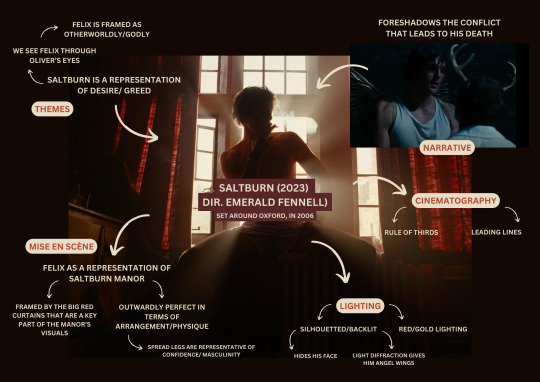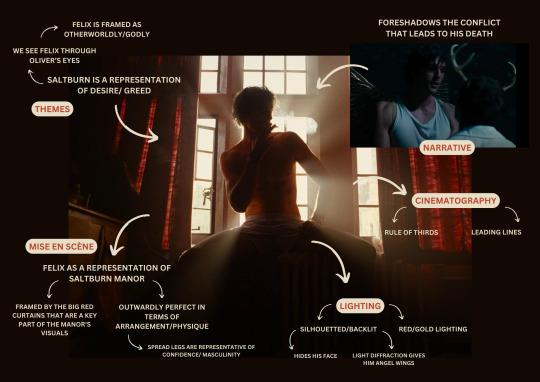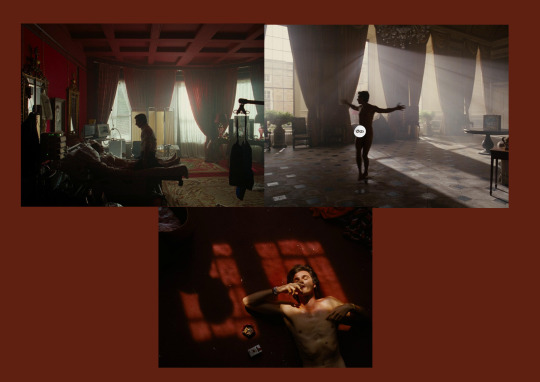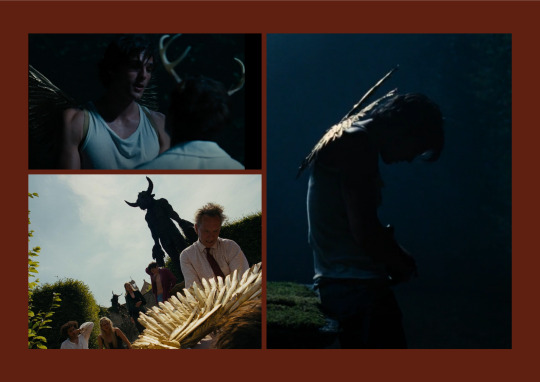L4 Motion Graphics and Animation student at AOD, Sri Lanka. This sideblog contains my coursework for Module MI4017, Intro to Filmmaking.
Don't wanna be here? Send us removal request.
Text
Final Project: Video Essay
Teamwork experience :>
Cain Cain was in charge of most of the graphic designs including the title cards and animations in the cultural transmission part of the video essay. She also edited the videos for the above mentioned part and the worldbuilding section of the video. She also captioned the whole video.
Cain wrote the parts in the script related to cultural transmission, and did majority of the research regarding it.
For the stage presentation, she edited in my points for most of the power point slides.
Malith Malith was in charge of creating the layout for the video, and editing the audio clips together.
He edited both our draft videos (the one for stage two presentations as well as the first final draft) He also did some editing later on, replacing the video clips with low quality.
He also did research and wrote the parts regarding the VFX used in the film, as well as the technology used for the original animated Mulan film.
Me
I made the avatars that were used in the video, which Cain removed the backgrounds of. I edited most of them in, except for the parts which Cain made by herself.
I also continued editing the video after the lecturer's feedback for the first draft. I edited in Cain's sections according to the order.
After Cain Malith and I decided the order in which our topics would go in, I made the script and listed down each clip we could use for it.
In terms of in cooperating feedback into our work, one of the things we were told constantly was to make our analysis less biased towards the animated film, and to try and be more objective.
I believe that we succeeded in doing this in our final video, as we compared the two films directly without overly getting into the negative aspects of both, and presenting an objective truth at the end. Instead of saying that the Mulan adaptation was worse than the original, we changed it by saying that the adaptation was less liked than the original by the general audience, and provided proof using articles and ratings.
Throughout the project, we made sure to keep in touch with each other and discuss our decisions. We made sure everyone was on the same page, dividing work according to our skills and weaknesses.
Balancing this project along with our other modules were hard, and since I was mostly done with the rest, I could help out little by little on their parts as well.
Despite facing many challenges during these few weeks, both Cain and Malith managed to pull through and do their designated parts, which I was very thankful for.
When discussing strengths and weaknesses, I identified that Cain is excellent at research and graphics, while Malith had an extensive knowledge on technical aspects of filmmaking as well as editing. My strengths were being punctual and organized with my work, which made it easier for me to divide my time and focus on my parts easily.
Since the three of us had never been in one group together, it was a bit hard at first to navigate the dynamics, but we were much less awkward on text than in real life, so it was fixed pretty quickly.
I had a lot of fun being one of the Fluffycheesecakes. Although times were hard, I'm quite proud of the final result >_<''
And now, for the biggest plot twist of the century:
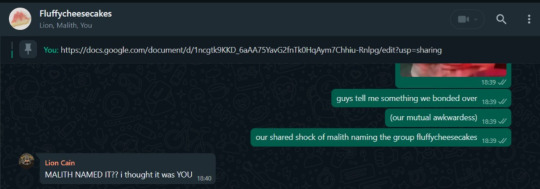
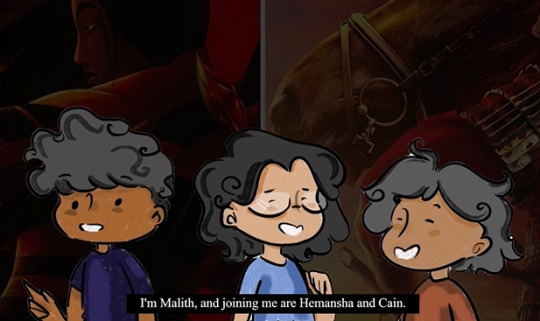
And that's all for this module!! Thanks for following me on this journey🥹
Signing off, Hemansha.
2024/10/08
4 notes
·
View notes
Text
CHALLENGES AND HOW WE OVERCAME THEM
The most difficult challenge we had to overcome was, surprisingly, an abundance of information. We had collected a mountain of research between the three of us under various subtopics, but we were having trouble compressing it into a 15 minute segment. This was especially apparent in our Stage 01 presentation, where our group talked for nearly (or maybe just over?) an hour, but as guest lecturer Cyrus pointed out, the topics we had researched had very little relation to each other, and we weren't properly contrasting the two films against each other the way we were meant to.
By Stage 02 we had definitely made an improvement, thanks to a feedback session with module lecturer Irushi as well as a session or two focusing on the technical and worldbuilding aspects of our films. We had included a video segment in our presentation, which helped us stay on track and within our time frame. As feedback, Cyrus and Irushi suggested that we work on presenting our information in a more objective way (we were rather biased against the live action and it showed), as well as further refining our subtopics.
We worked hard on this over the next few weeks, editing and restructuring our script in a way that made sure we were presenting our strongest information as succinctly as we could.
___________________________________
I would also say one of the challenges we also faced as a group from a social standpoint is that we are all very introverted people, and we were initially a bit averse to checking up on each other's progress or suggesting changes. This definitely changed over the course of the project, with all three members becoming a bit more vocal with our ideas, especially after we had all gotten comfortable with our individual role in the group. Hemansha, in particular, got really good at making sure everyone stayed on track.
The switch from an in-person presentation to a pre-recorded video essay also worked in our favor (we might have been the only group who were immediately pleased with the news), because it let us have a pre-written script and have animated avatars representing us, instead of showing our actual faces. We also got to take our time recording our voiceovers, which I personally was incredibly glad for, as I have some trouble reading aloud and also have a slight stammer that makes pronouncing some words difficult. It took 223 attempts, but I ended up with a recording I was pleased with!

___________________________________
In my opinion, I think our work paid off really well, and I am really proud of the final video essay we submitted.
0 notes
Text
ELABORATING ON INDIVIDUAL RESEARCH
ELABORATING ON INDIVIDUAL RESEARCH
While I unfortunately hadn't been keeping my blog updated when I really should have, this is a quick breakdown of some, if not most of my research for this project.
Starting out with what made it into the final cut of the video:
THE BALLAD OF MULAN
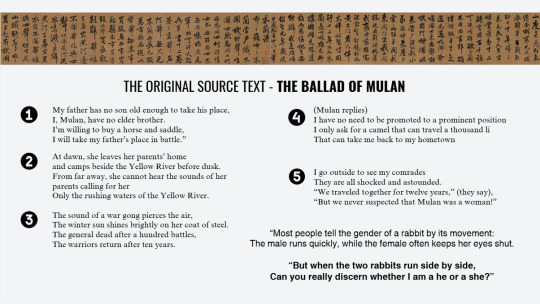
(^Slide from Stage 01 presentation)
This is the full script excerpt from my segment on The Ballad of Mulan and Mulan: Rise of a Warrior, which was later trimmed out of the final script due to time constraints.:
The inspiration behind both the 1998 and 2020 adaptations of Mulan is a poem from the Northern Wei era called The Ballad of Mulan. The ballad follows the legend of the folk hero Hua Mulan, a young girl who disguises herself as a man to join the army in her father's place. The ballad follows five main story beats, each of which is represented in both Disney adaptations of the story: Mulan's departure from her family home, her conscription, the culminating war, an offer of power and prosperity offered to her by the emperor, and finally, Mulan's humble return to her family. The ballad ends with the implication that men and women, while different on the surface, are equally capable when it comes down to it, a message that is notable for having a more feminist perspective in a time period that placed so much emphasis on traditional patriarchal values, and therefore acts as the central theme of both of Disney's Mulan adaptations. Interestingly, there was a Chinese film released in 2009, titled Mulan: Rise of a Warrior, which seemed to tone town this more feminist aspect, instead building the story around more communist values of laying aside personal happiness for the good of society, with Mulan putting her responsibilities as a soldier ahead of pursuing romance. This film, which was released in response to the popularity of Disney's 1998 Mulan musical, was also said to be one of the main inspirations for Disney's live action Mulan from 2020.
I thought it was interesting that both Disney adaptations as well as Rise of a Warrior all dutifully followed the five point storyline of the Ballad, but each represented them so differently.
WORLDBUILDING
Worldbuilding was researched on by both myself and Hemansha, and our research was further fine-tuned and narrowed down with feedback from module lecturer Irushi in a session devoted to worldbuilding (see below). We were particularly interested in the magic system and certain characters as vessels for worldbuilding, so it's something that was always in our script, though a lot of the smaller, more disconnected morsels of information had to be discarded in the final cut.
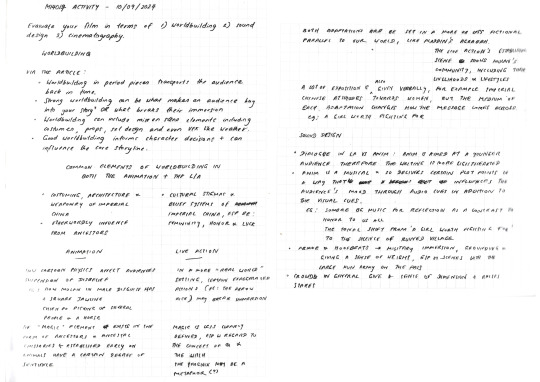
INTERCULTURAL TRANSMISSION
I stumbled upon this concept while I was trying to figure out a way to articulate why Mulan's representation fell short, despite seeming to have done a lot of cultural research (at least from the outside looking in). Implying that Disney was using Chinese culture as a narrative tool and nothing else felt reductionist, as interviews with the director, as well as the PR for both films seemed to show a great deal of appreciation for it, regardless of how the films themselves were received among audiences.
It was in the paper Chinese Elements in Film Mulan (2020) and Its Intercultural Transmission by Tingting Qian and Lijun Tang that I first heard of Stuart Hall's theory of encoding and decoding (the gist of which is that a message communicated by one person isn't necessarily going to be interpreted by someone else in exactly the way that it was intended), which to me explained so much of the disconnnect between Disney's non-Western filmmaking and the backlash it recieved.

(^Slide from Stage 01)
0 notes
Text
EDITING (INDIVIDUAL CONTRIBUTIONS)
While before this project I would never have considered editing something I would enjoy, I ended up having a lot of fun with adding visuals to the voiceover in this project!
SOUND EDITING
While Malith and Hemansha recorded their lines together, I was off sick that day and ended up recording my lines separately the following day, and then re-recording them over a few more times over the following couple of days, for a whopping total of 233 recordings. I then went into Adobe Audition to clean up and de-noise the final recording, before moving it into my editing software.
VIDEO EDITING
The video editing process took me a while as I was unused to it, but it was really interesting to figure out which visuals went well and flowed smoothly together, while also illustrating the point being spoken in a way that felt intentional.
I also got to add a couple flairs that I thought were fun, like cutting a clip on a point of impact (Mulan getting hit by a shuriken and Bori Khan being impaled by an arrow), and cutting back and forth between the Honor To Us All sequence of both films during the Representation segment (eg: 2D Mulan's paintbrush dipped in paint to live action Mulan's lips being painted).
ANIMATING SPRITES
Instead of showing our faces, we got to use these cartoon sprites drawn by Hemansha!

It was really fun getting to sync the individual frames to match the voiceover, and also strangely interesting to explore which gestures/expressions we inherently associate with specific tones.
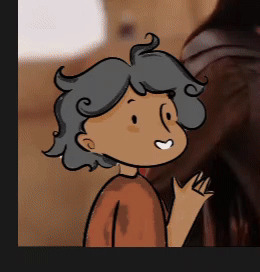
ANIMATED SLIDES
During my segment about Intercultural Transmission, I was afraid the static screenshots I'd added into the background would look too stiff, and detract from the video that was otherwise very colorful and dynamic, so I hopped into Canva to remake them with transitions and a bit more visual appeal!


I'm particularly proud of this one, as it took me a while to figure out how to illustrate the concepts of encoding and decoding with the limited clip art available on the software:
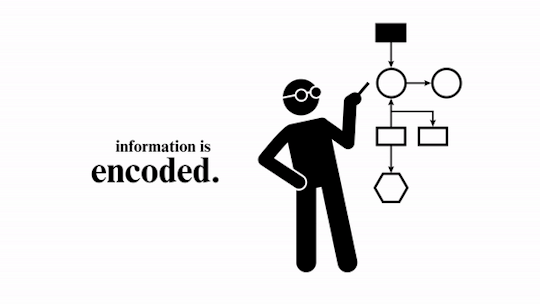
I also got to make the title screen and the subtitle screens, which I was really excited for:
CAPTIONING
Captioning was, by far, my favorite part of the editing process for this project. Initially, I was only meant to caption my own segments, as I felt my pronunciation was rather unclear at times, but afterwards we decided that we should add captions to the entire video, as it tied it together and made it look more professional visually, while also helping a lot with the overall clarity of our presentation.
It was also really fun to see auto-captioning try to interpret our names. I love my teammates, Hemanso and Mallet.
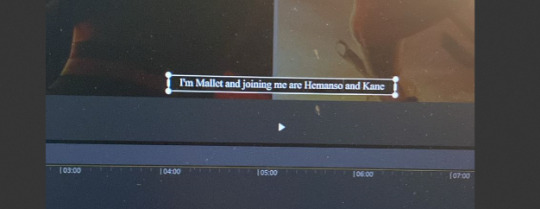
(Genuinely, as they handled the brunt of the heavy-duty editing and restructuring that I'm not sure I would have known where to even start with!)
0 notes
Text
INTRO TO EDITING - In-class Exercise
Using three provided images with a chosen sound to convey an original narrative. This video was created on Capcut.
The audio used for the edit is from this tiktok sound. The images provided by the lecturer can be found below the cut.
The images provided for this exercise (we were instructed to select one set of images):
SET 01




SET 02



0 notes
Text
The Maze and the Snowstorm:
An Analysis of Symbolism and Central Themes of The Shining
Stanley Kubrick and Diane Johnson’s The Shining (1980) is often referred to as one of the best-directed films ever made. While this is in part due to the iconic camerawork in the movie, haunting soundtrack and solid characterization of the protagonists, in my opinion what really sets it apart is its use of symbolic imagery to communicate subconscious messages that unsettle the audience beyond the outward content of the film itself. In this essay, I will be discussing the repeating symbols of the maze and the snowstorm, and how they represent the central themes of madness and isolation in the film, respectively.
. . . . .
THE MAZE
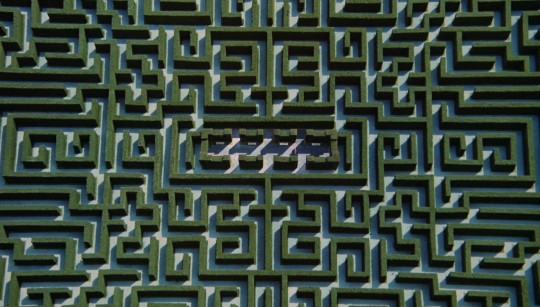
Firstly, the Overlook Maze. Perhaps one of the most memorable visuals in the film, the maze is a recurring symbol in the movie: in the form of the actual physical maze, but also mirrored in the layout of the Overlook Hotel itself, with its high ceilings and narrow corridors that contribute so much to the film’s distinctive mise en scène.

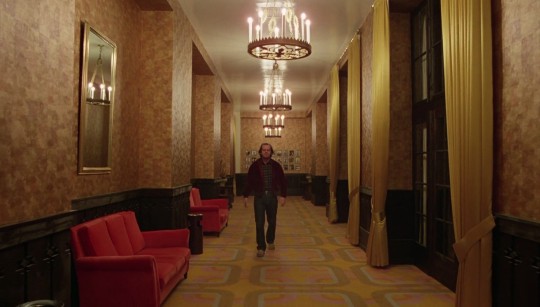
While this set design serves its purpose in setting the claustrophobic, paranoia-inducing atmosphere of the film, I believe it also acts as a visual representation of Jack’s descent into madness, and the reality break experienced by all three protagonists. I feel this connection is best represented by the scenes from 26:20 to 27:40, where shots of Wendy and Danny navigating the maze are interspersed with Jack roaming the twists and turns of the Hotel, seemingly in a near-manic state.
youtube
. . . . .
THE SNOWSTORM
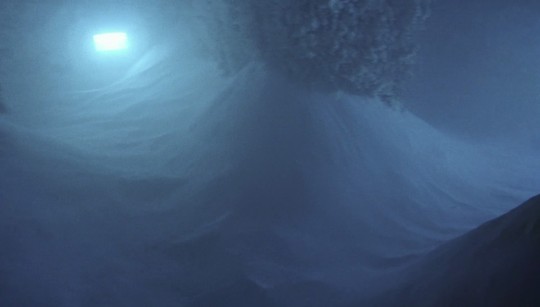
Going back to the mise en scène of the film, something else that stood out to me the most about the film’s production design was the busy, maximalist patterns and vivid colors present in the background of most shots set at the Overlook Hotel, be it set decor, or the clothing of the actors themselves. While this contributes massively to the dizzying, almost psychedelic visual look of the film, it also makes the cut to the snowstorm far more visually jarring to the viewer. The vast, empty white scenescape of the snowstorm contrasts heavily against the warmer, more “filled” look of shots filmed inside the hotel, which I think really drives home one of the central motifs of the film: isolation.


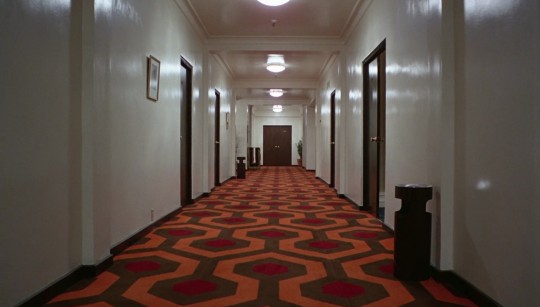

The snowstorm is initially what confines the Torrances to the Outlook Hotel, and physically isolates them from the outside world, and is therefore, by extension, the catalyst to Jack’s rapid descent into madness. I believe there is also an element of personal isolation experienced by each family member (each represented by the long tracking shots centered on each character scattered throughout the film): Jack’s isolation caused by alcoholism and his struggles to write, Wendy’s isolation caused by her strained relationship with her husband, and Danny’s isolation caused by his psychic abilities and disconnect from his parents.
. . . . .
In summary, I believe one of the main strengths of the film lies in the main themes of the film, madness and isolation, being further emphasized by their physical representations in the form of the maze and the snowstorm.
. . . . .
LECTURER FEEDBACK:
2 notes
·
View notes

